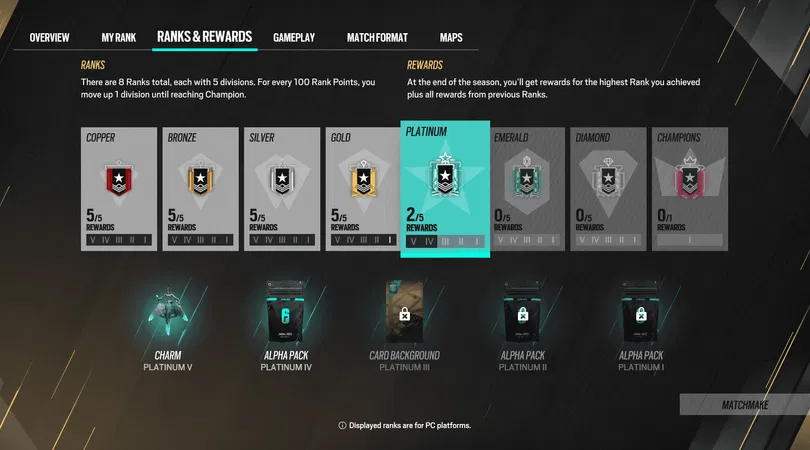Explication du système de classement de Rainbow Six Siege
Dans Rainbow Six Siege, votre rang est plus qu'un simple badge. C'est votre réputation, votre histoire et vos compétences.
Pendant des années, le chemin vers le sommet a été une ascension délicate et frustrante, marquée par un mystérieux MMR que vous ne pouviez pas voir. Mais avec la sortie de Ranked 2.0, les choses ont complètement changé.
Le nouveau système est plus épuré, plus transparent et conçu pour récompenser le grind. Mais comment cela fonctionne-t-il ? Et comment passer des tranchées du Cuivre à celles du Champion ?
Dans cet article, nous allons décortiquer l'ensemble du système de classement de Rainbow Six Siege, de ses niveaux fondamentaux aux mécanismes qui vous aideront à grimper.
Fonctionnement du nouveau système de classement R6
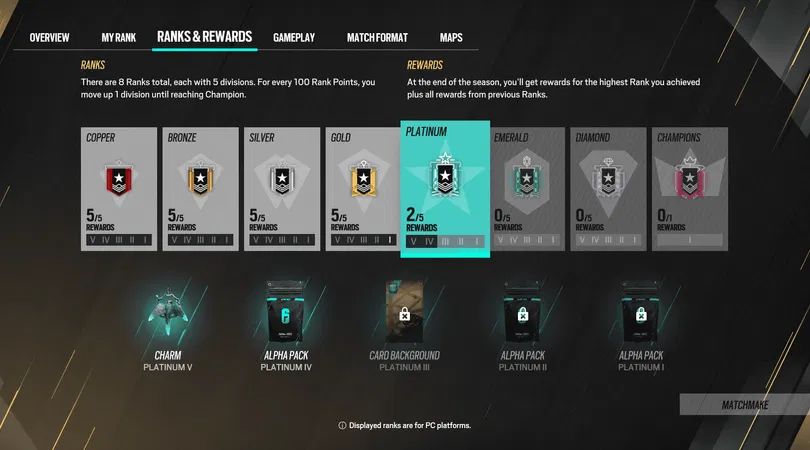
Oubliez ce que vous pensiez savoir sur le système de classement de Siege : la mise à jour 2.0 a tout changé.
Comment cela fonctionne-t-il ? Le système sépare désormais votre rang visible (l'emblème sur votre profil) de votre note de compétence cachée.
Quelle est la différence ? Pensez-y de la façon suivante : votre rang est votre rapport, tandis que votre note de compétence est votre record, c'est-à-dire l'évaluation précise de vos compétences par le jeu.
Cela signifie que chaque saison, tout le monde commence son ascension en partant du bas de l'échelle : Cuivre V. Mais pas de panique. Votre cote de compétence cachée vous permet de ne pas jouer contre de vrais joueurs de cuivre.
Au lieu de cela, le système de matchmaking vous place contre des adversaires d'un niveau similaire, ce qui vous permet de gravir les échelons à un rythme qui reflète votre niveau de compétence réel.
C'est une bonne chose, car un joueur de niveau Diamant peut passer rapidement les niveaux inférieurs en quelques jours, tandis qu'un joueur de niveau Argent trouvera son niveau dans ces rangs.
Il s'agit d'un système conçu pour que chaque match soit compétitif et que chaque victoire soit méritée.
Tous les rangs de la R6 dans l'ordre
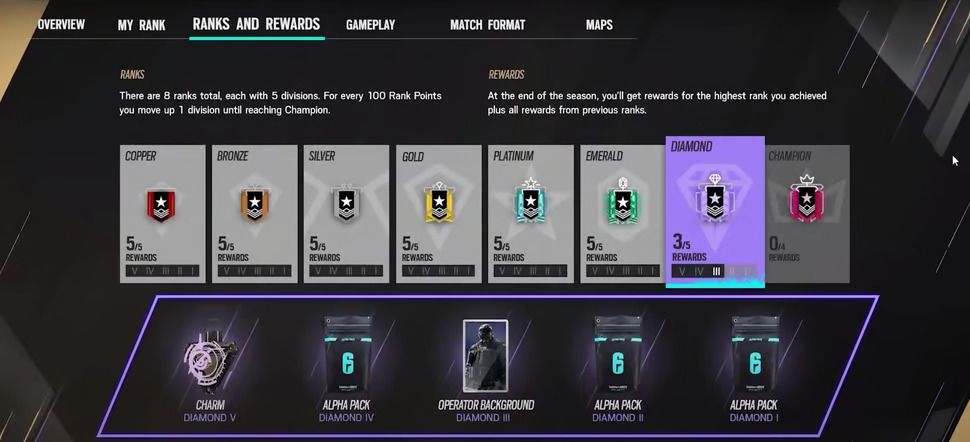
L'échelle elle-même se compose de huit niveaux uniques, dont sept sont divisés en cinq sections. Pour grimper, vous devez gagner 100 points de rang (PR) pour passer d'une division à l'autre (par exemple, de Gold III à Gold II). Voici les niveaux dans l'ordre :
- Cuivre (V-I)
- Bronze (V-I)
- Argent (V-I)
- Or (V-I)
- Platine (V-I)
- Émeraude (V-I ) - Ce nouveau niveau Émeraude a été introduit avec Ranked 2.0 pour faciliter l'ascension entre Platine et Diamant.
- Diamant (V-I)
- Champion - Contrairement aux autres niveaux, Champion est un rang unique sans division, réservé aux meilleurs joueurs du monde qui dépassent les 5 000 RP.
Différences entre Ranked 2.0 et l'ancien système de classement
L'ancien système et le nouveau sont deux mondes différents. Voici un bref aperçu des changements intervenus :
|
Dossier |
L'ancienne méthode |
Classement 2.0 |
|---|---|---|
|
Point de départ |
10 matchs de placement déterminent le rang initial. |
Tous les joueurs commencent au niveau Cuivre V chaque saison. |
|
Mesure de la progression |
Le classement de matchmaking (MMR) est le rang visible. |
Les points de rang (PR) font progresser le rang visible. |
|
Base du matchmaking |
Votre MMR visible. |
Une note de compétence cachée, distincte de votre rang. |
|
Restrictions sur les groupes |
Limites strictes de MMR pour les membres d'un groupe. |
Aucune restriction de rang : jouez avec n'importe lequel de vos amis. |
|
Sensation d'escalade |
Souvent punitif, avec de grandes variations de MMR et des schtroumpfs. |
Plus prévisible, avec des gains de RP réguliers par victoire. |
Votre guide pour monter en grade dans R6S
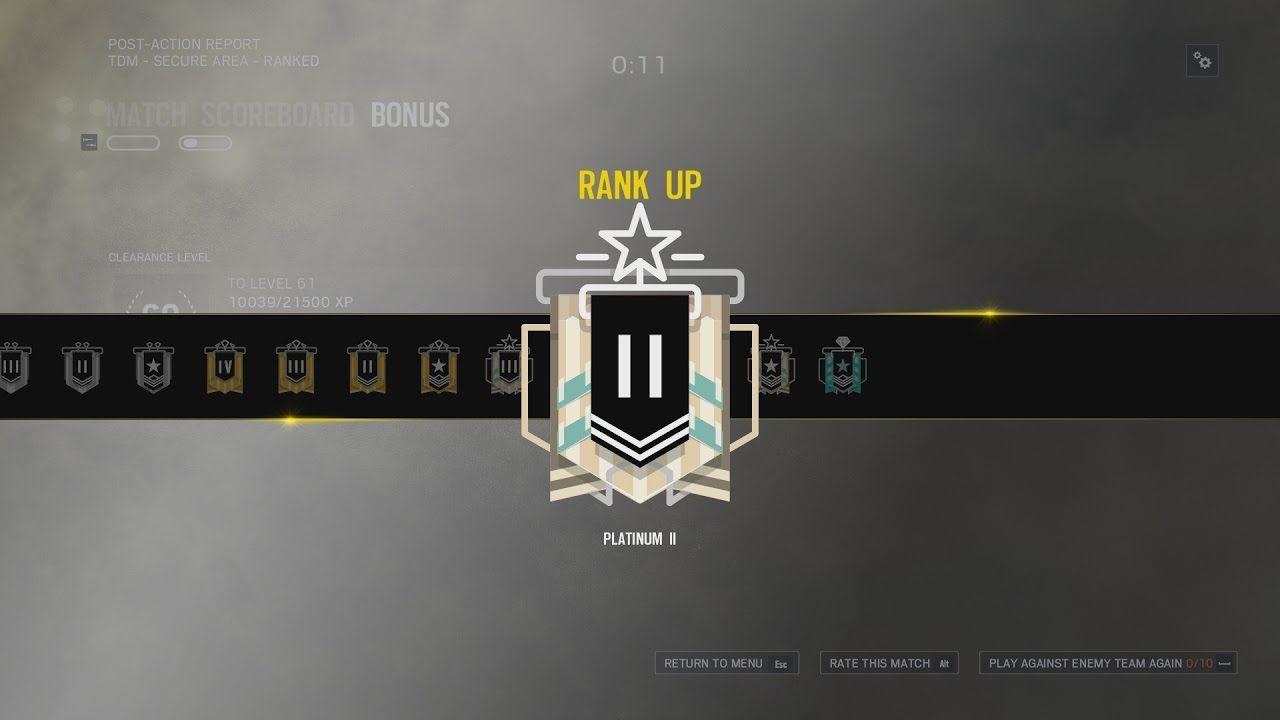
Dans Ranked 2.0, la progression est incroyablement simple...
Une victoire vous rapporte des RP, une défaite vous en coûte. Mais c'est dans le montant que vous gagnez ou perdez qu'intervient la valeur cachée de votre Compétence.
Supposons que le système détermine que vous êtes un joueur de haut niveau actuellement dans un rang inférieur (par exemple, un joueur de platine en argent). Dans ce cas, vous gagnerez une grande quantité de PR pour une victoire et perdrez très peu pour une défaite, car le jeu essaie activement de vous faire progresser vers votre "vrai" rang.
Au fur et à mesure que votre rang visible se rapproche de votre compétence cachée, ces gains et ces pertes commencent à se stabiliser, généralement autour de +/- 25 RP par match. Cela atténue la douleur d'une défaite fortuite contre une équipe plus faible et récompense la constance, en faisant de nombreuses victoires régulières contre les adversaires la véritable clé de l'ascension.
Comment commencer à jouer en mode classé dans Rainbow Six Siege ?
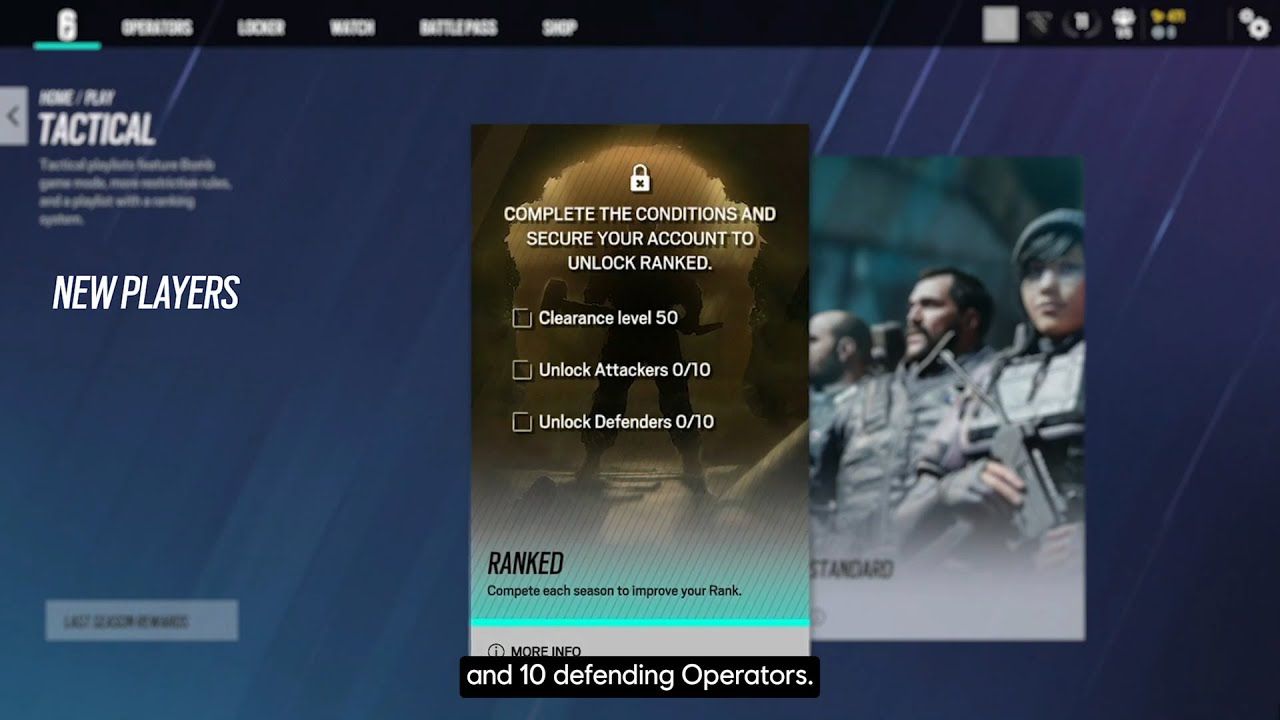
Avant de pouvoir tester vos compétences sur l'échelle compétitive, vous devrez remplir une condition préalable mineure : atteindre le niveau d'habilitation 50.
Les développeurs ont pris cette décision comme une étape d'intégration, car au niveau 50, vous êtes censé avoir une connaissance de base des cartes, une poignée d'opérateurs pour l'attaque et la défense, et une compréhension générale des mécanismes de Siege.
Une fois que vous avez atteint le niveau 50, le mode de jeu classé se débloque et il n'y a plus de matchs de placement. Au lieu de cela, vous pouvez vous lancer directement et commencer votre ascension depuis le cuivre V. C'est également à ce moment-là que vous rencontrerez pour la première fois la phase de sélection et de bannissement, qui apporte un peu de stratégie supplémentaire, où les équipes alternent le bannissement d'un attaquant et d'un défenseur pendant toute la durée du match.
Récompenses de rang et gains saisonniers
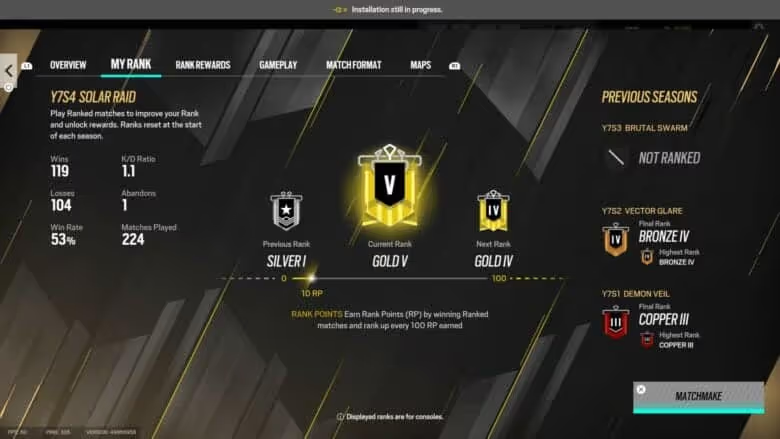
À la fin de chaque saison, Ubisoft distribue des récompenses dans le jeu en fonction du rang le plus élevé que vous avez atteint au cours de cette saison. Ces récompenses se présentent généralement sous la forme d'objets cosmétiques R6S, tels que :
- Charmes d'armes
- Arrière-plans et badges
Ces objets sont uniques à chaque saison, ce qui en fait des objets à collectionner en édition limitée. C'est la raison pour laquelle les joueurs achètent des services professionnels de boosting de R6 pour les obtenir.
Qu'est-ce qui sépare les grands des bons ?
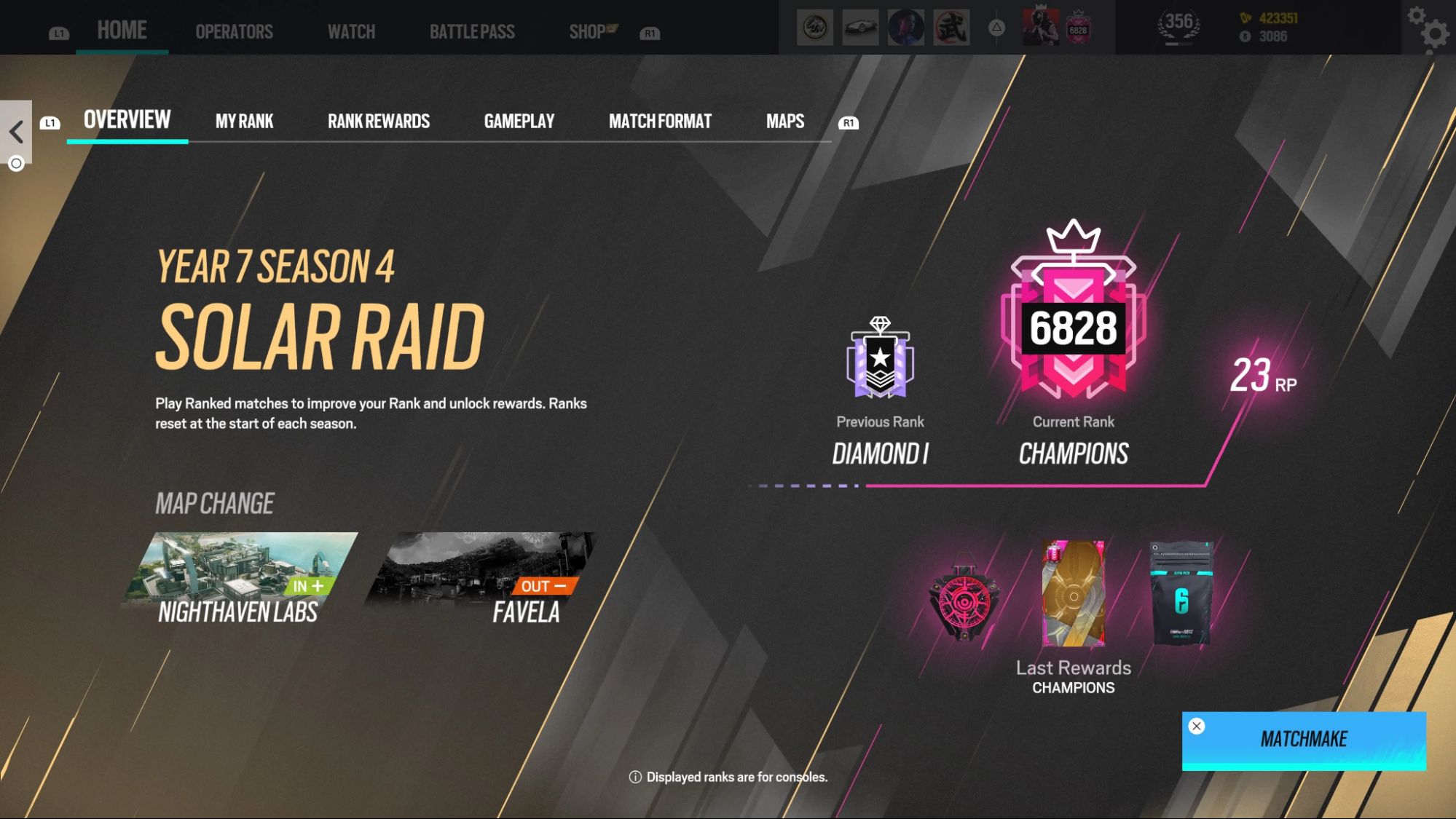
Pour passer de l'or au platine, il faut améliorer sa mécanique et sa connaissance des cartes. Cependant, pour atteindre les niveaux Diamant et Champion, il faut quelque chose de plus :
- L'information : Le siège de haut niveau est un jeu d'information, qui nécessite uneutilisation proactive des drones, un excellent travail de caméra et des compétences de communication claires.
- Stratégie : Les champions ne se contentent pas de mettre en place des sites par défaut ; ils s'adaptent et amènent des opérateurs spécialement pour contrer la stratégie de leurs adversaires. Les meilleurs joueurs comprennent également l'économie d'utilité et savent quand utiliser un explosif pour dégager un bouclier plutôt que de le garder pour une couverture déployable.
- Mental : la capacité à garder son sang-froid après avoir perdu un 1v3, à se remettre à zéro après un mauvais round et à diriger est ce qui fait les meilleurs joueurs.
Dans l'ensemble, le nouveau système de classement de Rainbow Six Siege est une ascension unique et gratifiante qui mesure précisément vos compétences. Quel est le rang le plus élevé que vous ayez atteint ? Que pensez-vous du nouveau système ? N'hésitez pas à nous en faire part !
